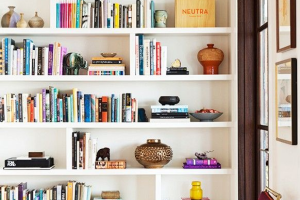10 Creative Ways to Style Your Bookshelf

When it comes to interior design, creating a space that reflects one’s personality can be both a rewarding and challenging endeavor. Many people find themselves overwhelmed with the endless possibilities. Whether you’re refreshing a room or starting from scratch, understanding key design principles can significantly ease this process.
- 10 Creative Ways to Style Your Bookshelf
- Embrace Your Style
- The Impact of Environment
- Utilizing Different Textures
- Incorporating Plants
- Mixing Materials
- Color Coordination
- Rainbow Order
- Monochromatic Scheme
- Personalizing with Art and Objects
- Displaying Collectibles
- Showcasing Artwork
- Functional Organization
- Using Baskets and Bins
- Dividing into Sections
- Creating Visual Balance
- Symmetrical Arrangement
- Asymmetrical Display
- Styling with Lighting
- Adding String Lights
- Incorporating Lamps
- Showcasing Books in Different Ways
- Stacking Horizontally and Vertically
- Arranging by Genre
- Minimizing Clutter
- Decluttering Regularly
- Opting for Minimalist Display
- Customizing with DIY Projects
- Installing Shelves
- Adding Decorative Backing
Embrace Your Style
Finding your unique style is the first step:
- Identify Inspirations: Look through magazines, Pinterest, or even nature for what resonates with you.
- Mix and Match: Your space can be eclectic; don’t shy away from blending styles and eras.
The Impact of Environment
A well-designed space can uplift the mood, inspire creativity, and even enhance productivity. For instance, when I redecorated my home office, adding vibrant colors and textures made it a place I looked forward to working in. The journey to an inviting, cohesive environment starts with the exciting exploration of design elements that speak to you. Let’s uncover how to integrate different textures, colors, and personalized touches to make your space uniquely yours!
Utilizing Different Textures
Creating a dynamic and inviting space often stems from the thoughtful use of textures. By layering different materials, you not only elevate the aesthetic appeal but also create a tactile experience that can transform any room.
Incorporating Plants
Plants are a fantastic way to introduce texture and life into your space. They bring nature indoors and can soften hard surfaces.
- Types of Plants to Consider:
- Fiddle Leaf Fig: Large leaves create a bold statement.
- Succulents: Easy to maintain and come in various shapes.
- Pothos: Trailing vines add an organic touch.
I remember adding a lush snake plant to my living room, which instantly brightened the area and added a refreshing contrast against my sleek furniture.
Mixing Materials
The beauty of mixing materials lies in the visual depth it brings. Combining wood, metal, glass, and fabric can create a rich tapestry of textures.
- Ideas for Mixing Materials:
- Wooden Furniture with Metal Accents: A rustic table paired with metal chairs.
- Soft Fabrics Against Hard Surfaces: Cozy cushions on a leather couch.
For instance, I used a wooden coffee table with a glass top, resulting in an eye-catching mix that encourages conversation. Embracing textured elements in your decor can lead to spaces that feel alive, balanced, and irresistibly inviting!
Color Coordination
Effective color coordination is essential in crafting a harmonious interior. The right colors can evoke emotions, influence moods, and create visual interest. Here, we’ll explore two popular methods to enliven your space: arranging colors in rainbow order and embracing a monochromatic scheme.
Rainbow Order
Organizing colors in rainbow order can create a playful and vibrant atmosphere. This method works wonderfully for bookshelves, art displays, or decorative objects.
- Tips for Achieving Success:
- Use Bright and Bold Color Palettes: Think reds, oranges, yellows, greens, and blues.
- Choose Accessories: Colorful vases or cushions can add splashes of color.
When I arranged my bookshelf in this playful manner, it became a focal point that sparked joy and creativity every time I entered the room.
Monochromatic Scheme
Alternatively, a monochromatic scheme utilizes varying shades of one color, offering a serene, cohesive look.
- Benefits of a Monochromatic Palette:
- Increases Visual Harmony: Different shades create a sophisticated transition.
- Easy to Implement: It requires less decision-making on color combinations.
For example, using different tones of blue in my bedroom—from light sky blue curtains to deep navy bedding—created a calming oasis perfect for relaxation. Both methods can transform your space—choose the one that speaks to your personal style and ambiance!
Personalizing with Art and Objects
Adding personal touches to a space through art and collectibles not only reflects individuality but also creates a warm atmosphere. Incorporating meaningful pieces can turn a house into a home, making it uniquely yours.
Displaying Collectibles
Your collectibles tell stories and offer glimpses into your interests. A well-curated display can become a captivating conversation starter.
- Ways to Showcase Collectibles:
- Shadow Boxes: Create a dimensional display for smaller items.
- Floating Shelves: Perfect for showcasing a mix of collectibles without overcrowding.
I have a collection of vintage cameras displayed on a floating shelf above my desk. They not only serve as a nod to my love for photography but also add character to the space.
Showcasing Artwork
Artwork can breathe life into any room and evoke emotions that resonate with you.
- Considerations for Displaying Art:
- Gallery Wall: Combine different sizes and styles for a dynamic look.
- Framing: Utilize cohesive frames for a polished appearance.
For instance, my gallery wall, filled with photographs from my travels, continually inspires daydreams of new adventures. By personalizing your space with art and objects, you can create an inviting environment that truly reflects your journey.
Functional Organization
A well-organized space leads to a more efficient and enjoyable environment. By focusing on functional organization, you can ensure that everything has its place and that your space remains clutter-free. This not only enhances aesthetics but also boosts productivity.
Using Baskets and Bins
Baskets and bins are not only practical but can also add to the décor. Utilizing these storage solutions can rein in chaos and bring order to your rooms.
- Benefits of Baskets and Bins:
- Versatile Sizing: Available in various sizes for different needs.
- Aesthetic Appeal: Choose styles that complement your decor theme.
In my living room, I use wicker baskets to store blankets and magazines, creating an inviting vibe while keeping items accessible.
Dividing into Sections
Creating sections within a room can help in organizing items based on purpose or category. This technique enhances function without sacrificing design.
- Tips for Dividing Areas:
- Rugs: Use area rugs to define spaces, particularly in open layouts.
- Furniture Arrangement: Arrange furniture in a way that creates natural groupings.
For example, in my home office, I’ve established a dedicated reading nook with a cozy chair and a small bookshelf, creating a clear division between work and relaxation spaces. By implementing functional organization, you can enjoy an efficient and harmonious environment that feels like a sanctuary.
Creating Visual Balance
Visual balance plays a crucial role in interior design, ensuring that a space feels harmonious and inviting. Achieving this balance can be done through two primary methods: symmetrical arrangement and asymmetrical display. Each brings a distinct aesthetic appeal and can drastically influence the overall feel of your home.
Symmetrical Arrangement
A symmetrical arrangement creates a sense of order and calm, making it one of the most traditional approaches in design.
- Features of Symmetry:
- Mirror Images: Place identical items, like lamps or chairs, on either side of a focal point.
- Center Focus: Anchor the design with a central piece, such as a large painting or a statement piece of furniture.
For instance, in my dining room, I opted for two matching side tables and lamps on either side of a central console. The result? An elegant and cohesive look that feels effortlessly balanced.
Asymmetrical Display
On the other hand, asymmetrical design embraces a more casual and dynamic style, adding interest and character.
- Elements of Asymmetry:
- Varied Heights: Use various heights and shapes to create a more visual tension.
- Unexpected Pairings: Mix contrasting elements for a whimsy vibe.
In my living room, I’ve arranged a collection of books and decorative objects of varying sizes on a single shelf, creating an inviting sense of movement. By experimenting with both symmetrical and asymmetrical arrangements, you can find the perfect balance that resonates with your personal style!
Styling with Lighting
Lighting often acts as the unsung hero in interior design, transforming a space from ordinary to extraordinary. By carefully choosing how you light your rooms, you can set the mood, highlight design features, and create warmth. Two effective methods for achieving the perfect ambiance are adding string lights and incorporating lamps.
Adding String Lights
String lights have a magical quality that can instantly enhance the atmosphere of any room. They are versatile and can be used in various ways.
- Creative Uses for String Lights:
- Accent Features: Drape them over headboards or around windows.
- Outdoor Spaces: Hang them on patios for an inviting outdoor feel.
When I wrapped string lights around my balcony railing, it transformed the space into a cozy retreat, perfect for evening gatherings or quiet relaxation.
Incorporating Lamps
Lamps provide both functional lighting and decorative flair, making them a staple in any well-designed space.
- Types of Lamps to Consider:
- Table Lamps: Great for reading nooks or side tables.
- Floor Lamps: Perfect for adding height and vibrant light to corners.
In my living room, I’ve placed a stylish floor lamp beside my favorite chair, which not only illuminates the space beautifully but also adds a pop of style. By thoughtfully styling with lighting, you can breathe life into your home and create an atmosphere that encapsulates comfort and personality!
Showcasing Books in Different Ways
Books not only serve as a gateway to different worlds but also make for beautiful decorative elements in any space. By showcasing your books thoughtfully, you can enhance the aesthetics of a room while making a personal statement. Two creative methods include stacking books horizontally and vertically, as well as arranging them by genre.
Stacking Horizontally and Vertically
Combining horizontal and vertical stacks of books creates visual interest and breaks the monotony of traditional shelving.
- Tips for Displaying Books:
- Vary Heights: Alternate between stacked books and upright books to achieve balance.
- Incorporate Decor: Use bookends or decorative objects to add flair.
In my home office, I’ve paired vertical stacks of novels with horizontal ones atop colorful coasters, which creates a fun, layered look that inspires creativity.
Arranging by Genre
Organizing your books by genre not only makes finding your next read easier but also adds a personal touch to your display.
- Ways to Sort Your Collection:
- Color Coding: Place similar colors together for a stunning visual effect.
- Theme-Based: Group books based on themes, like travel, science fiction, or cookbooks.
I personally love having my travel-related books prominently displayed in the living room, inviting guests to browse and share stories. By showcasing your books in diverse ways, you can create an appealing and personalized library that reflects your interests and passions!
Minimizing Clutter
A clutter-free space can significantly enhance both the aesthetic and mental clarity of your home. By adopting practices to minimize clutter, you can create an environment that feels serene and organized. Two effective strategies in this effort include regular decluttering and opting for a minimalist display.
Decluttering Regularly
Making decluttering a regular habit can prevent accumulated mess and stress. It’s easier to maintain order over time than to tackle an overwhelming pile later.
- Tips for Effective Decluttering:
- Set a Schedule: Dedicate time weekly or monthly to assess items.
- Use the ‘One In, One Out’ Rule: For every new item brought into your home, consider letting go of an old one.
When I implemented a monthly decluttering day, I was surprised at how freeing it felt—turning what once felt chaotic into a more manageable space.
Opting for Minimalist Display
Minimalist displays focus on showcasing fewer items but with more impact, allowing each piece to shine.
- Benefits of Minimalism:
- Reduces Distraction: A clean display makes it easier to appreciate decor.
- Enhances Space: A minimalist approach can make a room feel more open.
In my dining area, I chose a single statement vase instead of multiple cluttered decorations. The simplicity creates an elegant focal point. By integrating these strategies, you can enjoy a more peaceful and organized living environment!
Customizing with DIY Projects
Customizing your space with DIY projects can be an incredibly rewarding way to infuse your personality into your home. Not only can these projects save money, but they also provide a sense of accomplishment. Two impactful DIY endeavors are installing shelves and adding decorative backing.
Installing Shelves
Installing shelves can create additional storage space while showcasing your favorite items. The beauty of DIY shelves is that you can design them to suit your style and needs.
- Ideas for Installing Shelves:
- Floating Shelves: Create a clean, modern look by mounting shelves without visible brackets.
- Corner Shelves: Utilize underused space for added storage.
When I installed floating shelves in my kitchen, I was amazed by how they transformed the room, allowing me to display decorative jars and plants while keeping my countertops clear.
Adding Decorative Backing
Adding decorative backing to shelves or bookcases can make items pop and bring a splash of color or texture to your space.
- Ways to Apply Decorative Backing:
- Peel-and-Stick Wallpaper: Easy to apply and available in various designs.
- Fabric or Paint: Use fabric for a soft touch, or paint for a bolder statement.
I opted for a vibrant floral peel-and-stick wallpaper behind my living room shelves, which turned a simple display into a stunning focal point. Through these DIY projects, you can customize your home, making each corner distinctly yours and brimming with character!




